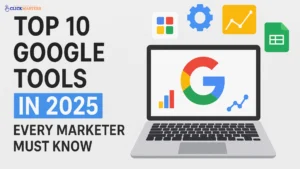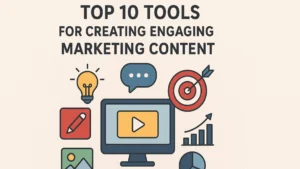Evaluating the success of an Off-Page SEO campaign is key to long-term growth. It helps check if backlinks, brand mentions, and social engagement are boosting your website’s authority. By tracking key metrics, you can evaluate the success of an Off-Page SEO strategy and avoid penalties from bad links. Monitoring Off-Page SEO helps businesses improve high-performing strategies, increase referral traffic, and boost brand visibility. This leads to better rankings and higher conversions over time.
Key Indicators to Track Off-Page SEO Success
To evaluate whether your off-page SEO strategy is effective, you need to track specific performance indicators. Below are the most crucial metrics that can help determine the success of your efforts:
1. Growth in High-Quality Backlinks
- Increase in the number of backlinks from authoritative websites.
- Growth in referring domains, showing diversity in link-building sources.
- Improved anchor text relevance in backlinks.
- Reduction in toxic or spammy backlinks that can harm rankings.
Boosting Domain Authority (DA) & Page Authority (PA)
- A higher DA/PA score indicates stronger trust and credibility.
- Positive changes in Trust Flow and Citation Flow (Majestic SEO metrics).
- An increase in page-level authority for targeted landing pages.
3. Increase in Organic and Referral Traffic
- Growth in organic traffic due to improved search engine rankings.
- More referral traffic from high-authority backlinks.
- Increased direct traffic, indicating brand recognition from external mentions.
4. Increase Brand Mentions (With or Without Backlinks)
- More mentions on forums, blogs, and news websites (linked or unlinked).
- Increased visibility in social media discussions and shares.
- Higher Google Alerts notifications for your brand name.
5.Higher SERP Rankings for Targeted Keywords
- Higher rankings for primary and long-tail keywords.
- More appearances in featured snippets and knowledge panels.
- Consistent ranking improvements tracked using Google Search Console or SEMrush.
6. Growth in Social Engagement and Shares
- More shares, likes, and comments on content linked to your site.
- Increased user interaction on social media platforms.
- Higher engagement rates from influencer collaborations and mentions.
7. Better Click-Through Rates (CTR) from External Links
- Higher CTR from backlinks means users find your content valuable.
- A decline in bounce rate, showing visitors stay longer on your site.
- Increased time on page from referral sources, proving link relevance.
8. Higher Conversions and Lead Generation
- More inquiries, sign-ups, or purchases from referral traffic.
- Increased email subscriptions or contact form submissions.
- Better customer engagement and retention from SEO-driven leads.
Not sure if your Off-Page SEO is working? ClickMasters provides expert insights, backlink tracking, and strategic solutions to improve your rankings and online presence.
✅ Increase Your Domain Authority
✅ Get High-Quality Backlinks
✅ Improve SERP Rankings & Traffic
📈 Take Your SEO to the Next Level! Click below to get started.
What is Off-Page SEO?
Off-page SEO refers to the strategies and actions taken outside of your own website to improve its position in search engine rankings. Unlike on-page SEO, which focuses on optimizing elements like content, keywords, and meta tags within your website, off-page SEO focuses on increasing your site’s authority and trustworthiness through external factors.
Off-Page SEO vs. On-Page SEO: Key Differences Explained
On-page SEO involves optimizing the content, structure, and elements within your website, such as titles, headers, meta tags, keywords, and internal linking.
Off-page SEO, on the other hand, focuses on external signals that can affect your site’s rankings. These signals are not directly controllable through your website’s code or content but are critical in boosting authority and trustworthiness.
- Examples of off-page SEO techniques (backlinks, social signals, guest posting, etc.).
Backlinks:
- Obtaining high-quality backlinks from authoritative websites signals to search engines that your content is valuable and trustworthy.
- Strategies include guest posting, broken link building, and earning backlinks from industry leaders and bloggers.
Social Signals:
- Social media engagement, such as shares, likes, and comments, indicates the popularity and relevance of your content.
- Active social media campaigns can drive referral traffic to your site, which impacts your SEO performance.
Guest Posting:
- Writing content for other blogs or websites within your niche allows you to showcase expertise and gain backlinks to your site.
- This strategy helps you reach a broader audience and earn credibility within your industry.
Brand Mentions:
- Mentions of your brand or website across forums, blogs, and other platforms—even without a direct link—can improve your site’s SEO.
- Search engines recognize these mentions as signals of trust and relevance.
Influencer Marketing:
- Partnering with influencers in your niche can bring more exposure to your site, improving visibility and earning high-quality backlinks.
Why is Off-Page SEO Important for Your Website?
- Contributes to Domain Authority and Search Rankings:
Off-page SEO strategies help build your website’s domain authority, directly impacting how search engines rank your site. Higher domain authority increases the chances of ranking higher in search engine results, making off-page SEO an integral part of any SEO strategy. - The Impact of Backlinks and Social Proof on Organic Traffic:
Backlinks from reputable sites not only improve rankings but also drive referral traffic. Similarly, social signals and brand mentions enhance brand visibility, contributing to an increase in organic traffic. - Google Emphasizes E-E-A-T:
Google’s ranking algorithms prioritize E-E-A-T (Experience, Expertise, Authoritativeness, and Trustworthiness). Off-page SEO signals such as backlinks, brand mentions, and social proof play a vital role in demonstrating your site’s expertise and authoritativeness. This helps build trust with search engines and users, ultimately improving rankings.
Essential Metrics & KPIs to Track SEO Performance

Backlink Quality and Quantity
How to Check the Number of Backlinks Using Tools Like Ahrefs, SEMrush, and Google Search Console
- Ahrefs: This tool provides a detailed backlink profile of any website. By entering a URL into the Ahrefs site explorer, you can access information about the total backlink volume, referring domains, anchor texts, and more. It also highlights the quality of these links with metrics like Domain Rating (DR) and URL Rating (UR).
- SEMrush: SEMrush offers a Backlink Analytics tool that shows the amount of backlinks and referring domains, as well as the overall health of your backlink profile. It provides insights into toxic backlinks and opportunities to acquire more quality links.
- Google Search Console: This free tool from Google shows the top linking sites and the total total backlinks pointing to your website. Though less detailed than Ahrefs or SEMrush, it’s still a good starting point for tracking your backlinks and understanding which pages are attracting the most links.
Importance of High-Authority Backlinks vs. Low-Quality Spam Links
- High-Authority Backlinks: Links from websites with high domain authority (DA) or PageRank are valuable for SEO. These backlinks signal to search engines that your website is trusted and relevant.
For example, backlinks from industry leaders, well-known media outlets, or educational institutions have significant SEO value. High-quality backlinks can drive more referral traffic, increase your site’s credibility, and lead to higher rankings on search engine results pages (SERPs).
- Low-Quality Spam Links: On the other hand, low-quality links (such as those from link farms, directories, or irrelevant websites) can harm your SEO efforts. Search engines like Google use algorithms such as Penguin to penalize websites that acquire spammy backlinks. These penalties can lead to a drop in rankings or, in extreme cases, removal from search engine indexes altogether. Therefore, it’s crucial to focus on acquiring backlinks from trustworthy, relevant, and authoritative sources.
Anchor Text Analysis and How It Affects SEO
- Anchor Text is the clickable text in a hyperlink that points to another webpage. It provides context to both users and search engines about the content of the linked page.
- Exact Match Anchor Text: Using the target keyword as anchor text can help improve rankings for that specific keyword, but overusing it can result in keyword stuffing and penalties.
- Branded Anchor Text: Using the brand name (e.g., “Nike.com”) as anchor text is natural and generally safe.
- Partial Match Anchor Text: This type of anchor text uses variations of the target keyword and is the most balanced approach for SEO.
- Generic Anchor Text: Phrases like “click here” or “read more” are neutral and safe, but they don’t contribute much to SEO.
- Naked URLs: Using the URL as anchor text (e.g., “https://example.com“) is also a neutral approach and can diversify your backlink profile.
The balance and diversity of anchor text types in your backlink profile are important for creating a natural-looking link profile. Overuse of exact match anchors can trigger penalties, so a healthy mix of branded, partial match, and generic anchor text is ideal for SEO.
Domain Authority (DA) and Page Authority (PA) Improvement
Explanation of Moz’s DA and PA Scores
- Domain Authority (DA): DA is a metric developed by Moz that predicts how well a website will rank on search engine result pages (SERPs). The score ranges from 1 to 100, with higher scores indicating a higher likelihood of ranking well. DA is calculated based on various factors, including the quantity of external links, the quality of those backlinks, and overall site trustworthiness. A higher DA generally suggests that a website has strong SEO and a solid backlink profile.
- Page Authority (PA): Similar to DA, PA measures the ranking potential of a specific page on your website, not the entire domain. PA is also scored from 1 to 100 and is determined by factors such as backlinks pointing to that page, the quality of those backlinks, and other on-page SEO elements. PA is particularly useful when you want to track the authority of individual pages rather than the entire domain.
How to Track Changes in Authority Over Time
Tracking DA and PA changes over time is crucial for understanding how your backlinking initiatives are impacting your site’s overall authority. Here’s how you can monitor these metrics:
- Moz Link Explorer: Moz provides its Link Explorer tool, which allows you to track both DA and PA scores over time. You can enter your website’s URL and view its current DA and PA scores as well as changes in authority over specific periods. Moz also provides insights into what might be influencing these changes, such as new backlinks or lost links.
- SEMrush: SEMrush offers an Authority Score that evaluates domain strength in a similar way to DA. You can use it to track your domain’s authority growth.
- Ahrefs: Ahrefs provides Domain Rating (DR), a similar metric to DA. It helps you monitor your site’s backlink profile and how it contributes to your overall site authority.
- Google Search Console: While Google Search Console doesn’t show DA or PA directly, it does provide valuable insights into how Google views your website and how your pages are performing in search results. Monitoring changes in impressions, clicks, and positions can give you a general idea of whether your DA and PA are improving.
- Higher DA/PA Improves Rankings: Generally, a website with a higher DA is more likely to rank better on search engine results. The same applies to PA—pages with higher PA tend to rank higher for their targeted keywords.
- Increased Organic Traffic: As your DA and PA grow, you can expect more organic traffic. Higher authority leads to better rankings, which means more visibility and more clicks. Quality backlinks play a significant role in boosting DA and PA, which in turn drive more traffic to your site.
- Stronger Link Profile: Tracking DA and PA changes gives you insights into the health of your link profile. A consistent increase in these scores usually reflects a steady acquisition of high-quality backlinks, which directly contribute to better SEO performance.
The Correlation Between DA/PA Growth and SEO Performance
In summary, improving DA and PA is not just about acquiring backlinks—it’s about acquiring the right kind of backlinks from authoritative and relevant sources. Monitoring these metrics can help you assess the effectiveness of your offsite optimization practices and make necessary adjustments to your strategy.
Using Google Analytics to Measure Referral Traffic from Backlinks
- Google Analytics is a powerful tool for tracking referral traffic, which includes visitors coming to your website from external sources like backlinks. To measure referral traffic from backlinks, you can:
- Navigate to Acquisition > All Traffic > Referrals in Google Analytics.
- Here, you’ll see a list of all the websites that are linking to your site and sending traffic.
- By comparing referral traffic data over time, you can determine which backlinks are driving the most visitors to your site.
- If your external SEOstrategies, such as guest posts or influencer collaborations, are successful, you should see an increase in the number of visitors coming from those referring websites.
- Additionally, by looking at metrics such as session duration, bounce rate, and pages per session, you can assess the quality of traffic coming from those backlinks and ensure that the traffic is relevant and engaged.
Tracking Increases in Organic Search Traffic as an Indicator of Successful Off-Page SEO
- One of the main indicators of successful off-page SEO is the increase in organic search traffic. This can be tracked in Google Analytics under Acquisition > All Traffic > Channels, where you can select Organic Search to see the traffic coming from search engines like Google, Bing, or Yahoo.
- If your link-building activities are effective (e.g., high-quality backlinks, social signals), you should notice a gradual increase in organic search traffic over time.
- Changes in SERP rankings, fueled by strong off-page SEO, usually correlate with a growth in organic traffic. For instance, improving your rankings for competitive keywords will bring more organic visitors to your website.
- SEO tools like Google Search Console or SEMrush can also track keyword performance and how ranking improvements lead to increased organic search traffic. If you’re targeting long-tail keywords through guest posts or backlinking, these improvements can be particularly noticeable.
The Importance of Geo-Targeted Traffic for Local SEO Strategies
- Geo-targeted traffic is particularly important for local businesses aiming to improve their local SEO. Local SEO efforts often involve optimizing for location-specific keywords, getting listed in Google My Business, and acquiring local backlinks.
- Using Google Analytics, you can monitor traffic coming from specific geographic locations by setting up location-based filters. Navigate to Audience > Geo > Location to view which regions or cities are sending traffic to your site.
- This data can reveal whether your local SEO efforts, such as acquiring backlinks from local businesses, local directory listings, or regional blogs, are driving traffic from the desired geographical areas.
- For local SEO, geo-targeted traffic not only improves search engine rankings but also ensures that you are reaching the right audience, which is critical for increasing foot traffic, local inquiries, and sales.
By tracking organic traffic growth, especially geo-targeted traffic, you can gauge the success of your off-page SEO efforts and refine your strategy to focus on high-performing areas. Increased organic traffic from backlinks and local sources is a clear sign that your off-page SEO strategies are having a positive impact.
Brand Mentions and Social Signals
Monitoring Brand Mentions (With or Without Backlinks)
Brand mentions referring to whenever your brand name is mentioned online, whether it includes a backlink or not. Even if there’s no direct link, Google considers brand mentions as a trust signal, influencing your site’s authority.
📌 How to Track Brand Mentions?
- Use Google Alerts to receive notifications when your brand is mentioned.
- Tools like Ahrefs Content Explorer, Mention, and Brand24 help monitor brand mentions across the web.
- Check for unlinked mentions and reach out to webmasters to request a backlink.
How does Social Media Engagement Contribute to Off-Page SEO?
While social media links are no-follow, they still help in SEO by:
✅ Driving referral traffic to your website.
✅ Increasing brand visibility and trust.
✅ Boosting content engagement, making it more likely to earn natural backlinks.
🔹 Key Metrics to Track:
- Shares & Retweets → Wider content reach.
- Comments & Discussions → Higher engagement = better authority.
- Influencer Mentions → If influencers mention your brand, it increases credibility.
The Role of Reddit, Quora, and Forums in Brand Visibility
Reddit, Quora, and niche forums can significantly boost brand awareness when used strategically.
- Reddit: Participate in relevant subreddits, provide value, and subtly mention your brand when appropriate.
- Quora: Answer industry-related questions and include links to your site where it adds value.
- Forums & Communities: Engage in niche forums related to your business to establish authority and drive targeted traffic.
💡 Pro Tip: Don’t spam with links—focus on providing useful information first!
SERP Rankings and Keyword Performance
Tracking Keyword Rankings Before and After Off-Page SEO Efforts
Monitoring keyword rankings helps measure the effectiveness of off-page SEO strategies.
🔹 How to Track SERP Rankings?
- Use Google Search Console for keyword insights.
- Tools like SEMrush, Ahrefs, Moz, or Ubersuggest help track keyword movement.
- Monitor click-through rate (CTR) and organic impressions in Search Console.
🔹 How Off-Page SEO Affects Rankings?
✅ More high-quality backlinks → Higher domain authority → Better rankings.
✅ Increased brand mentions → Google considers brand popularity.
✅ Social signals and engagement → Indirectly influence rankings through increased visibility.
📈 Key Performance Indicators (KPIs) to Measure Off-Page SEO Success:
- Keyword ranking improvements.
- Increase in organic traffic.
- More high-quality referring domains.
- Higher brand search volume in Google Trends.
Tools to Measure Off-Page SEO Performance

Backlink Analysis Tools
Ahrefs – Backlink Checker & Domain Authority Tracking
Ahrefs is one of the most powerful backlink analysis tools that helps track:
✅ Backlink profile – See which sites are linking to you.
✅ Domain Rating (DR) & URL Rating (UR) – Measures the authority of your site.
✅ Broken backlinks – Identify lost or broken links and recover them.
💡 How to Use:
- Go to Ahrefs Site Explorer and enter your domain.
- Click on Backlinks to see your full backlink profile.
- Use the Lost Backlinks tab to reclaim valuable links.
🔹 SEMrush – Competitive Analysis for Backlink Gaps
SEMrush provides:
✅ Backlink gap analysis – Compare your backlinks with competitors.
✅ Toxic Score – Identify and remove harmful backlinks.
✅ New & lost backlinks tracking – Monitor your link-building efforts.
💡 How to Use:
- Go to SEMrush Backlink Analytics.
- Enter your website and competitors’ URLs.
- Identify high-quality sites your competitors are getting links from and target them.
🔹 Google Search Console – Free Backlink Monitoring & Insights
✅ Lists all backlinks recognized by Google.
✅ Identifies top linking sites and pages.
✅ Helps in removing spammy backlinks using the Disavow tool.
💡 How to Use:
- Go to Google Search Console > Links section.
- Check Top linking sites and Top linked pages.
- Download your links and analyze for any toxic backlinks.
Traffic and Performance Tracking
🔹 Google Analytics – Monitoring Referral Traffic & Visitor Behavior
✅ Tracks how much traffic comes from backlinks.
✅ Shows user behavior after clicking on an external link.
✅ Identifies which referral sites drive the most traffic.
💡 How to Use:
- Log in to Google Analytics.
- Navigate to Acquisition > All Traffic > Referrals.
- Analyze which backlinks bring in traffic and which pages they land on.
🔹 Google Search Console – Tracking Search Performance & Indexing Issues
✅ Monitors organic search traffic.
✅ Checks keyword rankings & impressions.
✅ Identifies indexing and crawling issues.
💡 How to Use:
- Go to Search Console > Performance tab.
- Analyze Top Queries to see which keywords bring the most traffic.
- Check the Coverage Report for indexing issues.
🔹 Ubersuggest – Checking Organic Traffic Trends
✅ Tracks domain traffic over time.
✅ Finds ranking keywords and estimated search traffic.
✅ Analyzes competitors’ top-performing pages.
💡 How to Use:
- Go to Ubersuggest and enter your domain.
- Check Traffic Overview to see estimated monthly traffic.
- Analyze Top Pages for content that attracts the most visitors.
Social Media & Brand Monitoring Tools
🔹BrandMentions – Tracking Brand Citations Across the Web
✅ Finds brand mentions even without backlinks.
✅ Monitors brand reputation in real-time.
✅ Tracks social media, news, and forums.
💡 How to Use:
- Sign up on BrandMentions.
- Enter your brand name and set alerts.
- Get notified when someone mentions your brand online.
🔹 BuzzSumo – Monitoring Content Performance & Social Engagement
✅ Identifies top-performing content.
✅ Tracks social media shares and engagement.
✅ Find influencers sharing your content.
💡 How to Use:
- Go to BuzzSumo and enter a keyword or brand name.
- Check Most Shared Content for engagement insights.
- Use the Influencers Tab to find people amplifying your content.
🔹 Google Alerts – Setting Up Alerts for Brand or Keyword Mentions
✅ Notifies you when your brand is mentioned anywhere online.
✅ Monitors competitors and industry trends.
✅ Helps in link-building by finding unlinked brand mentions.
💡 How to Use:
- Go to Google Alerts.
- Enter your brand name or keyword.
- Set alert frequency and sources (news, blogs, forums, etc.)
Common Mistakes to Avoid in Off-Page SEO Evaluation
Focusing Only on Backlink Quantity Instead of Quality
🔹 Why Spammy Backlinks Can Harm Your SEO Rankings
While having many backlinks may seem like a good strategy, quality matters more than quantity. Spammy or low-quality backlinks from irrelevant or suspicious sites can harm your SEO rankings. These links can signal to Google that your website might be involved in manipulative practices.
- Low-quality backlinks can be from link farms or unrelated industries, leading to penalties or algorithmic devaluation.
- Toxic backlinks can result in a decrease in domain authority and negatively affect your trustworthiness in the eyes of search engines.
🔹 Google’s Penguin Algorithm and Penalties for Bad Link-Building Practices
Google’s Penguin Algorithm is designed to detect and penalize websites with unnatural or spammy backlink profiles. If your website has been linked with irrelevant, low-quality, or spammy sites, it could receive a penalty or see its rankings drop dramatically. To avoid this:
- Focus on obtaining backlinks from high-quality, authoritative sites.
- Regularly use tools like Ahrefs, SEMrush, or Google Search Console to monitor your backlink profile for any toxic links.
Ignoring Brand Mentions Without Links
🔹 How Unlinked Brand Mentions Contribute to SEO
Unlinked brand mentions, where your brand is mentioned without an actual backlink, still contribute to your SEO strategy. Google sees brand mentions as a form of brand authority and trustworthiness. While they don’t directly pass link equity, they can indirectly influence your rankings by:
- Increasing brand recognition, leading to higher branded search volume.
- Improving your online reputation can increase the likelihood of gaining high-quality backlinks from other authoritative sources.
🔹 Why Monitoring NAP Consistency (Name, Address, Phone Number) Matters for Local SEO
For local SEO, ensuring consistency in your NAP (Name, Address, Phone Number) across various platforms (local directories, reviews, maps) is crucial. Inconsistent or incorrect NAP information can confuse, hurting your website’s ability to rank in local searches. Make sure to:
- Regularly check directories like Google My Business, Yelp, and Bing Places for correct NAP data.
- Use tools like Moz Local to ensure NAP consistency across platforms.
Not Tracking Off-Page SEO ROI
🔹 Understanding How Off-Page SEO Impacts Overall Conversion Rates
Off-page SEO strategies, such as link-building and brand mentions, should be aligned with your overall business goals, not just rankings. By tracking your ROI (Return on Investment) for off-page SEO efforts, you can understand how these strategies contribute to your bottom line. Key points to consider:
- Use Google Analytics to track conversion metrics like form submissions, purchases, and leads from referral traffic.
- Measure how backlinks and social signals influence visitor engagement and conversions, not just traffic volume.
🔹 Aligning Off-Page SEO Goals with Business Growth
Off-page SEO isn’t just about improving rankings; it’s about contributing to your overall business growth. When evaluating off-page SEO performance, ask yourself:
- How do these strategies help generate more qualified leads?
- Are these backlinks leading to meaningful conversions and engagement?
💡 Tip: Set specific off-page SEO goals that align with your business objectives, such as improving local visibility, increasing referral traffic, or boosting brand awareness.
Final Thoughts – How to Ensure Long-Term Off-Page SEO Success?
To ensure long-term off-page SEO success, it’s essential to focus on continuous evaluation and optimization of your off-page efforts. Here’s a summary of the key takeaways:
- Quality Over Quantity:
Building a large number of backlinks is not as important as acquiring high-quality, relevant links from authoritative websites. Avoid spammy backlinks, as they can harm your rankings, especially with Google’s Penguin algorithm. - Monitor Brand Mentions and Social Signals:
Even unlinked brand mentions can contribute to your website’s authority. Monitoring your brand mentions across social media, blogs, and forums helps increase brand visibility and trust, even if they don’t directly pass link equity. - Consistency in Local SEO:
NAP consistency across directories, reviews, and other online platforms is vital for local SEO. Ensure that your Name, Address, and Phone Number are consistent to avoid confusion and improve local rankings. - Track ROI of Off-Page SEO:
It’s important to measure how off-page SEO strategies contribute to conversions, not just rankings. Track referral traffic, leads, and sales through tools like Google Analytics to understand the real-world impact of your off-page efforts. - Align SEO with Business Growth:
Off-page SEO should support broader business goals, such as increasing brand awareness, generating leads, and building authority. Setting clear, measurable goals ensures that your off-page SEO efforts align with your business growth.
Evaluating Off-Page SEO Performance:
Regularly evaluate your off-page SEO efforts to identify areas for improvement. This includes monitoring:
- Backlink quality and diversity.
- Brand mentions across the web.
- Social media engagement and visibility.
- Local SEO consistency.
- Conversion metrics tied to referral traffic.
By consistently refining and tracking your off-page SEO strategy, you’ll build a strong online presence, improve your domain authority, and drive meaningful traffic, leading to sustainable SEO success over time.
Conclusion:
This blog post covers all the essential metrics and strategies for evaluating the success of an off-page SEO campaign. By tracking backlinks, monitoring brand mentions, and using analytics tools, businesses can refine their SEO efforts for better rankings and traffic.









